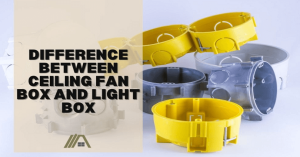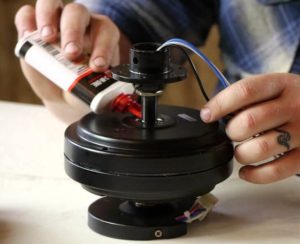Ceiling fans are commonly seen as cooling devices. However, they have the ability to assist in warming a room as well. This adds complexity to the role of ceiling fans.
By selecting the direction of your fan rotation, you can effectively reduce energy costs. Strategic reversal of the fan’s direction based on factors such as location, time of year, and accompanying heating or cooling devices can yield significant savings.
During summer, the fan should spin counterclockwise in order to push air down, regulate room temperature, and create a wind chill effect. On the other hand, during winter, the fan should spin clockwise to pull air up, balance room temperature, and displace warm air downwards. The optimal direction may vary depending on factors beyond just the season.
Ceiling Fans Have Reversible Rotation
To get all the necessary information about ceiling fan direction, it is important to have a reversible fan that can spin in both clockwise and counterclockwise directions.
If you are uncertain about your fan’s capabilities, there are ways to determine its functionality. The simplest method is to locate a reverse switch, which is typically found on the fan itself.
In most cases, the toggle switch is available near the motor housing, alongside the fan assembly, or concealed within the light fixture (you may need to remove the light shade to find it in this case).
If you cannot find a switch near the motor housing, there is still a possibility that it is located on your remote control or wall switch.
Alternatively, going through the manual or searching it online can provide valuable information about whether your ceiling fan has a reversible direction and where the switch is available.
Another useful indicator is the production date.
Most ceiling fans manufactured after the 1980s have the function to be reversed, although not all of them. Ceiling fans often exceed their expected lifespans, which means that many people might still possess fans manufactured prior to the 1980s.
Does Ceiling Fan Direction Matter?
The pitch of the blades on a ceiling fan allows them to effectively scoop air and generate airflow.
The direction of the fan matters because it is determined by the highest or lowest point of the blade pitch.
This, in turn, determines whether the air flows downwards or upwards.
When the fan rotates clockwise, it creates an upward flow of air, whereas counterclockwise rotation results in a downward flow of air.
When Ceiling Fans Spin Counterclockwise
Blades with a pitch have a distinct higher and lower side, where one section points more upwards and the other points more downwards.
Counterclockwise rotation, also called summer mode, is characterized by the highest point of the blade leading, which allows the air to be scooped along the blades and pushed downward.
To get a better understanding of how this downdraft is created, you can check the “Inferences Based on Blade Pitch” section in our article Which Way is Counterclockwise on a Ceiling Fan?
To determine if your fan is rotating counterclockwise, you can feel the downdraft beneath the fan or stand below it while it is running at a low speed. By looking up, you should observe the fan moving in a circle from right to left.
Another way to identify the mode of your fan is by viewing the blades from the side, provided they are moving slowly enough to find out the leading part of the blade. In summer mode, the higher portion of the blade should be leading.
The counterclockwise motion of the ceiling fan, known as summer mode, is optimal for cooling. It not only generates airflow but also eliminates hot pockets of air within the room, creating a wind chill effect.
This wind chill is useful for individuals positioned in the path of the air as it helps dissipate heat from their bodies, resulting in a cooling sensation
When Ceiling Fans Spin Clockwise
Clockwise rotation, called winter mode, is characterized by the lowest point of the blade leading, resulting in the air being scooped along the blades and pushed upward.
To better understand how this updraft is created, you can go through “Check the Blade Pitch” section in our article on Which Way Is Clockwise On A Ceiling Fan?
To determine if your fan is rotating clockwise, you can set it to high speed and stand below it. If it is in winter mode, you should only feel a gentle movement of air. However, if it is in summer mode, you will feel a more forceful airflow.
Additionally, same as counterclockwise rotation, you can determine the direction of the fan by observing it from below or by looking at the blades from the side.
When you are standing underneath the fan and looking up, the blades should be moving from left to right in winter mode. When you see them from the side, the lowest point of the blade should be leading.
During clockwise rotation, the air above the ceiling fan is displaced as air is drawn up from the lower areas of the room.
Unlike counterclockwise rotation, there is no cooling effect produced by this airflow. However, the circulation of air can enhance the overall comfort of the room by eliminating cold spots.
Seasons Can Determine Best Fan Direction
| Season | Best ceiling fan direction | Notes |
| Spring | At high temperatures: counterclockwise At low temperatures: clockwise | Depends on various factors, including the climate and the timing within the season. Ultimately, it comes down to your preference for either a cooling or warming effect. |
| Summer | Counterclockwise | You can get the cooling effect if you are in the path of the airflow. The airflow creates a cooling sensation. |
| Fall | At high temperatures: counterclockwise At low temperatures: clockwise | Only useful with external heat sources including HVAC heating or a fireplace. |
| Winter | Clockwise | Only useful with external heat source including HVAC heating or a fireplace. |
Other Factors That Influence Best Direction
Use in Conjunction with Other Systems
HVAC System
While counterclockwise rotation in ceiling fans does provide a cooling effect through wind chill, you should know that it is not as effective as using an HVAC system to cool your entire home.
Similarly, clockwise rotation in winter mode does not actively warm the room but rather enhances air circulation.
For efficient cooling, you should use your ceiling fan with air conditioning or central air systems. The wind chill factor created by the fan allows you to feel colder at less extreme temperatures, which can help reduce the need for setting the thermostat to lower temperatures.
During winter, using the central heating system along with a ceiling fan can help prevent the accumulation of hot air at the ceiling, which is its natural tendency.
You can distribute the warm air more effectively throughout the room by using a fan. This allows you to set the thermostat to a less extreme temperature since you benefit from the circulated heat instead of losing it to the ceiling.
The effectiveness of a ceiling fan and determining the best direction depends on the placement of the return vents and registers in the HVAC system. The positioning of these vents, whether they are located in the ceiling or upper parts of the room, or on the floor or lower parts of the room, plays an important role in determining the most suitable direction for the fan’s rotation.
| Season | Register location | Return vent location | Best ceiling fan direction | Notes |
| Summer | Ceiling/upper wall area | Ceiling/upper wall area | Counterclockwise | Ideal configuration; ceiling fan with this register/ return vent configuration boosts HVAC system airflow. |
| Summer | Ceiling/upper wall area | Floor/lower wall area | Counterclockwise | Semi-good configuration; ceiling fan boosts HVAC system airflow. |
| Summer | Floor/lower wall area | Ceiling/upper wall area | Clockwise | Semi-good configuration; ceiling fan acts against bad design. |
| Summer | Floor/lower wall area | Floor/lower wall area | Clockwise | Bad configuration; ceiling fan covers bad design. |
| Winter | Ceiling/upper wall area | Ceiling/upper wall area | Counterclockwise | Bad configuration; ceiling fan covers bad design. |
| Winter | Ceiling/upper wall area | Floor/lower wall area | Counterclockwise | Semi-good configuration; ceiling fan covers bad design. |
| Winter | Floor/lower wall area | Ceiling/upper wall area | Clockwise | Semi-good configuration; ceiling fan boosts HVAC system airflow. |
| Winter | Floor/lower wall area | Floor/lower wall area | Clockwise | Good configuration; ceiling fan boosts HVAC system airflow. |
Wood-Burning Unit
Ceiling fans can be used in conjunction with wood-burning units, and the recommended direction for this usage is clockwise. When the fan rotates clockwise, it pulls up cool and dense air from near the floor, displacing the warm air accumulated near the ceiling.
This action effectively removes cooler air from occupied parts of the room and allows warm air to circulate in those areas, providing greater comfort to the occupants.
For optimal performance, it is advisable to place the ceiling fan directly above the wood-burning unit. This placement allows it to effectively collect and redistribute the heat generated by the unit. By positioning the fan where the heat gathers, it can efficiently distribute the warmth.
Mini-Split AC Units
Unlike HVAC units that rely on ducting with registers and return vents, mini-split AC units operate without ducts.
They have a single output for cool air located in the indoor unit. While the absence of ducting reduces energy loss during air transportation, it also means that cold air is sourced from only one location.
To circulate the cool air effectively throughout the room, fans can be installed.
Placing a ceiling fan directly above the mini-split AC unit (or as close as possible while following the clearance rules) ensures optimal distribution of the cold air.
Both directions can be used to evenly disperse the cooled air, but counterclockwise rotation also adds a wind chill effect, enhancing the cooling sensation in the room.
Humidifiers
Humidifiers, in a unique manner, can be considered heat-generating devices.
While their primary function is to reduce air dryness, the moistened air they release tends to be warm because warm air has a greater capacity to capture and retain heat compared to cold air.
Consequently, determining the best ceiling fan direction would depend on your specific objective.
If your goal is to warm a room, clockwise rotation of the ceiling fan would effectively distribute the heated air from the humidifier evenly throughout the space. This rotation direction ensures that the warm air is propelled into the occupied areas of the room rather than accumulating at the ceiling.
On the other hand, if your intention is to humidify a room while minimizing the warming effect of the humidifier, counterclockwise rotation would be beneficial. This creates a wind chill effect, resulting in a perceived cooler sensation in the room.
Location of the Ceiling Fan
| Location | Ceiling fan direction in summer | Ceiling fan direction in winter | Notes |
| Loft | Counterclockwise | Clockwise | Lofts tend to be a warmer area of the home, which highlights summer mode usage. |
| Tall ceilings | Counterclockwise | Counterclockwise | Ceilings can be too tall for ceiling fans to perform better. But there are methods to enhance efficiency. |
| Outdoors | Counterclockwise | N/A | Fans are not the perfect choice for winter when the temperatures are too cold air supply is too extensive. |
| Top of staircase | Counterclockwise | Counterclockwise | Counterclockwise airflow is very helpful in the winter to force warm air down to the lower floors of two story houses. |
| Near windows | Clockwise | Clockwise | Counterclockwise motion too close to windows can hinder the entry of outside air. |
| Far from windows | Counterclockwise | Counterclockwise | Counterclockwise spin will draw air from the windows and circulate it into the house. |
Ceiling fans are not an ideal option when it comes to pulling in outside air through windows.



